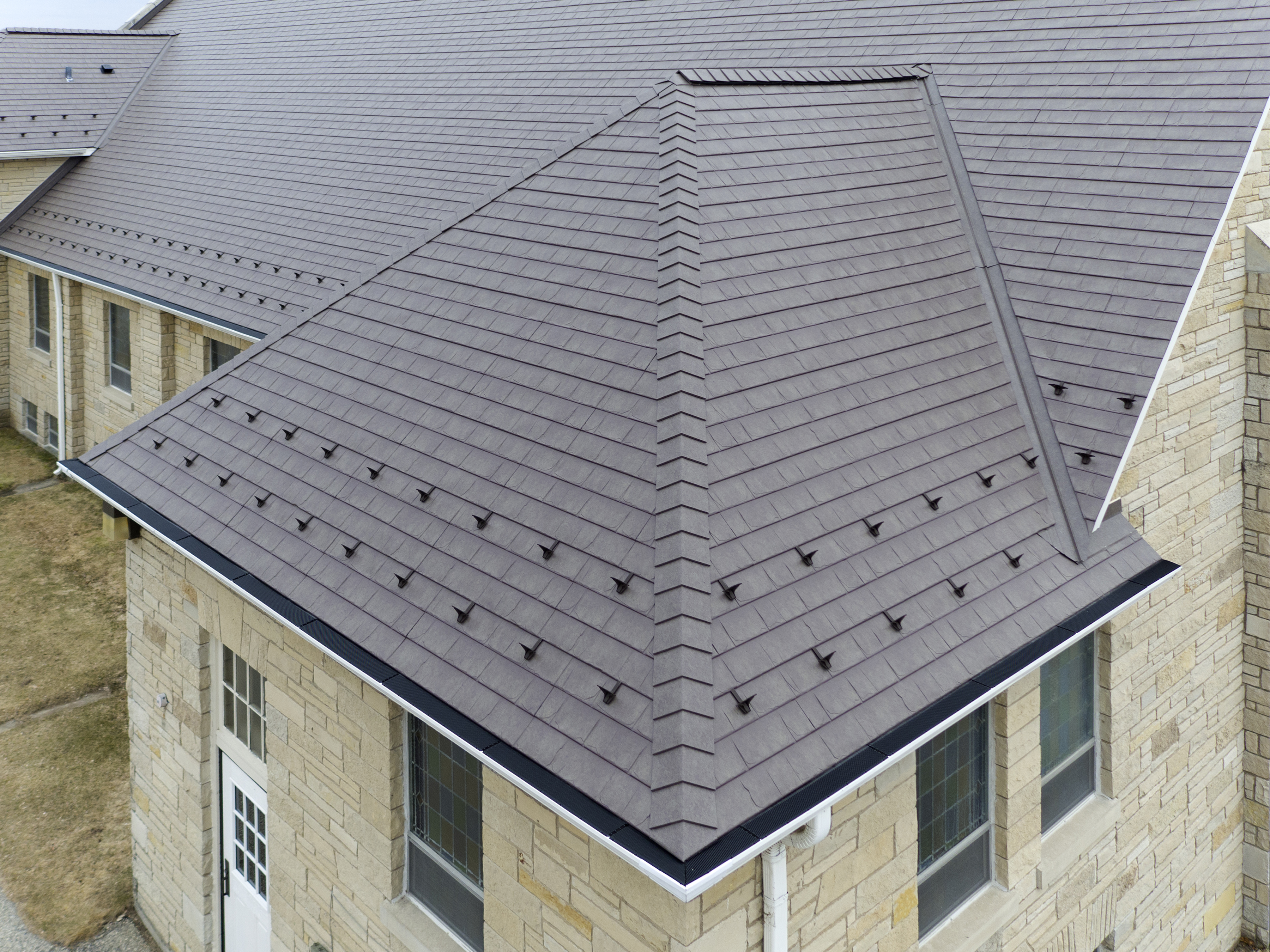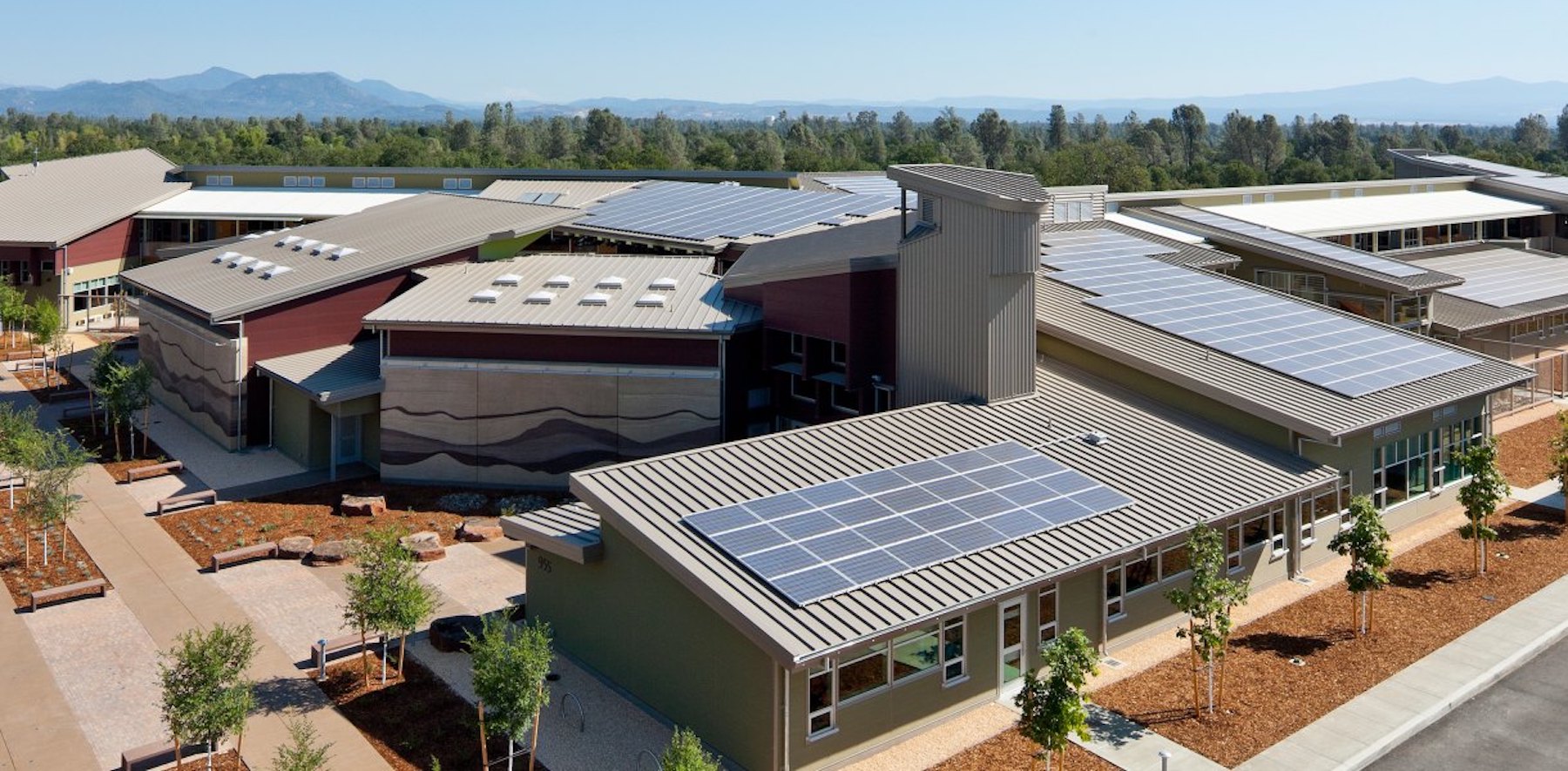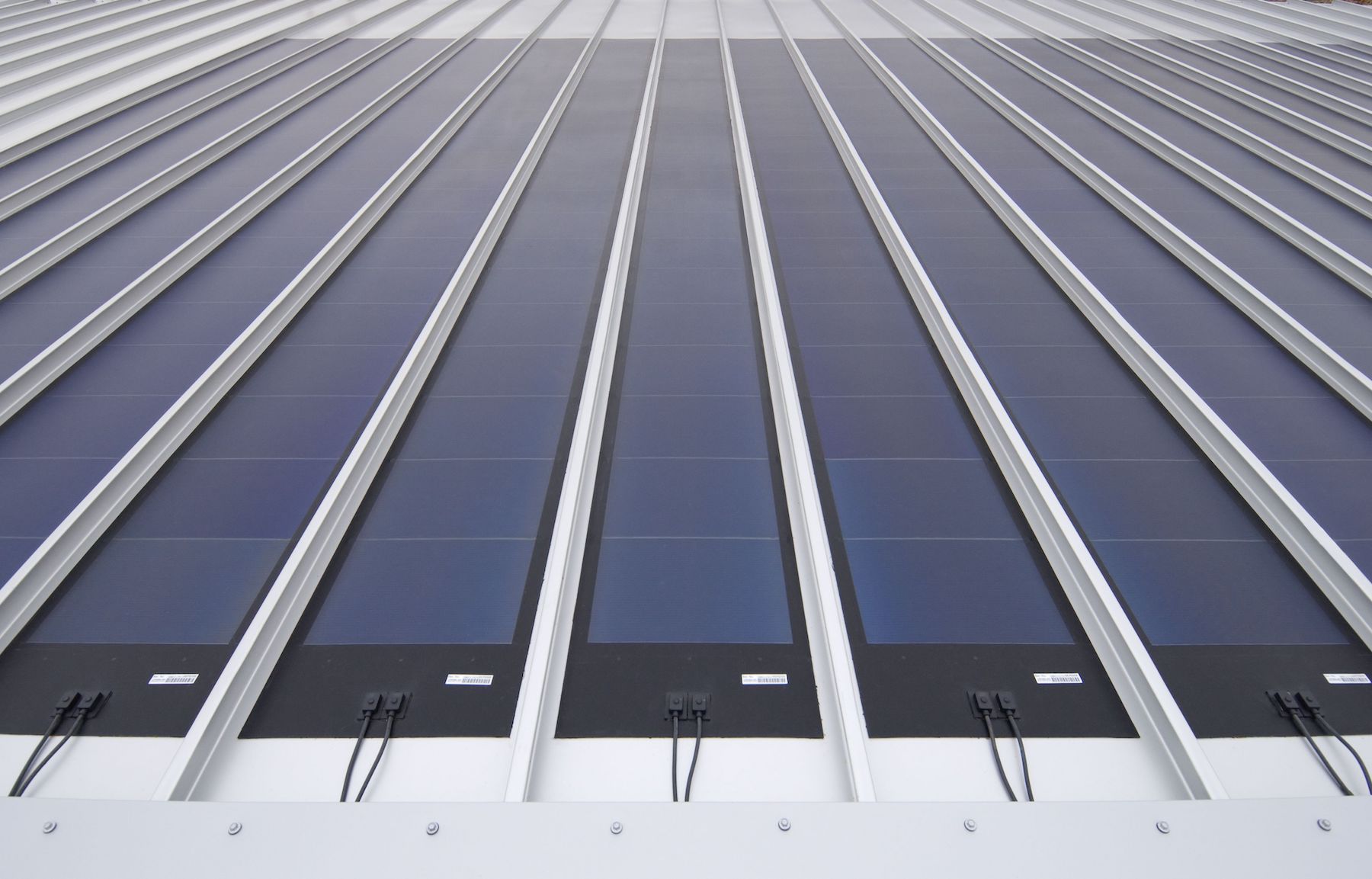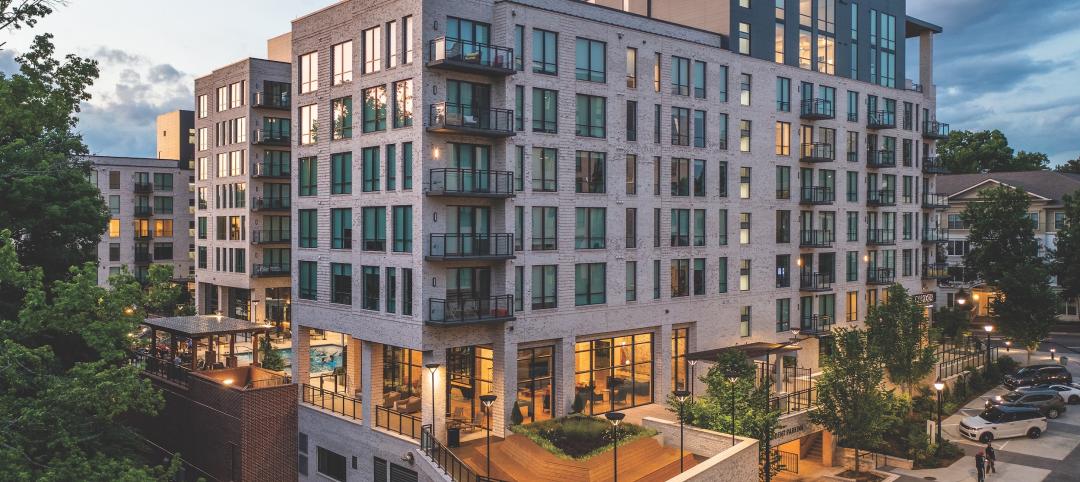Metal roofing trends
New ideas in design and constructability are radically changing how metal systems are used as roofing for commercial and institutional buildings.

New ideas in design and constructability are radically changing how metal systems are used as roofing for commercial and institutional buildings. Behind the investment in these new kinds of expressions and construction approaches is a growing interest in improved performance and reduced environmental impact. Metal roofing systems can cut cooling and heating loads significantly, according to the U.S. Environmental Protection Agency, which lists metal options in its Energy Star Roof Products Directory.
Those roofing assemblies offer solar reflectance and infrared emittance properties that lower peak energy demand, cut total energy usage, and (where “cool roofing” products are used) mitigate urban heat-island effects.
Metal roofs are exceptionally durable, says Mickey Conrad, AIA, LEED BD+C, Principal with LPA Inc. “Metal roofs give our clients the best performance over many years,” says Conrad, who often uses vertical standing-seam metal roofs with concealed fasteners. He warns that project teams must work carefully on flashing and waterproofing details to ensure effective joints and transitions for complex roof geometries.
THIS COURSE IS SUPPORTED BY:
Metallic-coated steel sheets dominate the commercial and institutional markets, offering low costs and long lifespans. Standard coatings include aluminum, lead-tin alloys known as terne, zinc (galvanized) finishes, and commercial aluminum-zinc alloys of 55% aluminum (trade name Galvalume) or 5% aluminum (Galfan). Project teams are also using more copper, stainless steel, and titanium and designing more complicated shapes, including curved roofs, as well as more photovoltaic-integrated materials.
Novel types and styles, such as standing-seam profiles, corrugated profiles, and stone-coated metal panels are gaining popularity. Textured and patterned metal roofing systems that simulate the look of Mediterranean clay tiles, traditional slate shingles, or wood shake are being used in historic college campuses and landmark reconstruction projects.
To replicate the appearance of tile or shingle roof surfaces, manufacturers shape deep-draw steel into the desired profiles and then mechanically preweather, age, and distress the visible sides. These faux applications “blend the authentic look of classic roof profiles with high wind and hail resistance and the solar reflectance of metal roofing,” says contractor Pinnacle Roofing. Pinnacle’s experts add that some of the shake, slate, and tile profiles are available in colors rated for solar reflectance values between 0.26 and 0.34, according to the Cool Roof Rating Council. The quasi-metal versions “can achieve a Class A fire rating and are fully recyclable at the end of their useful life,” according to Pinnacle.
Resiliency and metal enclosures
Resiliency is a major factor in the greater use of metal exteriors and roofing, notably for their ability to withstand hurricanes, wildfires, hailstorms, thunderstorms, and higher-than-average wind gusts in some locations, says enclosure expert John Ivanoff of BuroHappold Engineering.
Brad Johnson, a Vice President with Kingspan, says resilient roof systems can withstand extreme weather events and continue to perform and provide shelter. Metal, says Johnson, offers an option that is “tough and durable, wind- and impact-resistant, highly insulated, and appropriately reflective.”

“The lifespan of a properly installed metal roof can be up to 50 years, and metal roofs typically last three times longer than other roofing materials,” according to the trade group NextHaus Alliance. “A large piece of hail will damage anything it hits, but a metal roof will survive the impact much better than traditional roofing materials, contrary to some misperceptions about metal roofs,” says the alliance. Metal roofs also resist fire.
For wind resistance, metal roofing fasteners may be spaced eight inches apart instead of the typical 12 inches. Many projects call for 22-gauge metal as opposed to 24-gauge, increasing long-term performance and aesthetics, says contractor SPC Construction & Roofing.
Guidance from the Federal Emergency Management Agency fills out the picture on wind resistance and particularly wind uplift, a most critical structural capability. For standing seam and through-fastened metal panel systems, FEMA recommends specifying ASTM E 1592 testing, which “gives a better representation of the system’s uplift performance capability” as compared to UL 580, which is also allowed by the International Building Code. FEMA also encourages the use of ASTM E 1592 for architectural panels with concealed clips for the best understanding of installed performance. FEMA urges the use of ASTM E 1592 for through-fastened steel panel systems, whereas the IBC allows use of another reference (Chapter F in the standard NAS-01, published by the American Iron and Steel Institute) for determining the safety factor.
Additional specification tips and construction guidance are available in FEMA’s publication, Metal Roof Systems in High-Wind Regions. Savvy project teams have adopted the techniques for enhanced underlayments, stainless steel hardware in coastal zones, and reinforcements for eaves, ridges, and hips. Certain FEMA guidelines are now seen as best practices, such as the use of exposed fasteners rather than cleat attachments for hip, ridge, and rake flashings.
Winter hazards pose additional barriers to architectural resiliency in temperate zones. Accessories for safe, resilient roofs include staggered or continuous snow retention bars and individual snow guards (also called snow catchers), which prevent the movement of snow and ice down roof slopes. Vent pipe protectors for high-slope metal roofs reduce the impact of sliding snow and ice on chimney and vent assemblies. Snow guards are specified in clear polycarbonate, aluminum, and stainless steel, says Brion McMullen, President and CEO of IceBlox. For proper effect the pad-style guards should have a flat, forward-mounted face at least three inches wide by 2½ inches high.
Using the right attachments is the key to snow retention systems, says Clint Funderburk, a Vice President with LMCurbs. Typical solutions include surface gluing of individual pad-style snow guards. Mechanical attachments with set screws for standing seam ribs tend to be the best option for non-penetrating methods. Screw-down brackets are available for roof panels with exposed fasteners, but most roof panel manufacturers prefer clamp-on snow guards, as the nonpenetrating attachments will not compromise roof panel warranties. However, the glues used to attach surface-mount snow guards can adversely impact polyvinylidene fluoride resins in some coating formulations, warns Funderburk.
Project teams can choose from aligned or staggered guards or a continuous or staggered retention bar across the roof. Specialized pad shapes and custom snow-guard arrays can be seen across the frigid north, adding another aesthetic flourish.
Net zero and solar considerations
Metal roofing is associated with high performance and sustainable design, in part due to metal’s long life and recycled content, which can range from 25% to 95%, depending on the sources and alloys. But metal roofing systems also have a relatively good ratio of embodied energy to useful life and low levels of toxins produced in manufacture and installed use.

Properly executed metal roofing can significantly extend the life of the insulation, waterproofing, and substructure below well-specified and installed roof enclosures. Metal roof systems can be “reflective, easily vented, and help reduce heat gain into a building,” according to the Whole Building Design Guide.“Many products are also formed in ways that stop heat transfer through conduction by allowing only minimal contact between the metal and the underlying structure.”
Metal roofing can often be found on buildings seeking Passive House, LEED, and Living Building Challenge certification. For the Redding (Calif.) School of the Arts, a LEED Platinum public charter school designed to attain net-zero performance, the metal panel enclosures added “recycled content, durability, and an energy-friendly SRI value,” says James Theimer, AIA, Principal Architect at Trilogy Architecture, which designed the school. The team selected panel colors listed with Energy Star, which reduced the energy load needed for cooling in the Sacramento Valley. The roof’s pencil-rib standing seams provide a backdrop for a system of rigid photovoltaic panels across most of the exposed roof area, including a utility building fitted with PV laminate film solar panels. The roofing also matches the square metal wall panels and perforated soffit panels installed in the corridors as a pinboard for student artwork.
The integration of PV systems with metal roofing systems is increasingly common, helping to raise interest in both products for sustainability initiatives. This trend is also “driving demand for metal as an ideal platform designed to help protect an owner’s long-term investment,” says Renee Ramey, Executive Director of the Metal Roofing Alliance.
Commercial buildings with metal roofs include a new generation of net-zero retail stores. A newly built Walgreens in Evanston, Ill., has an exterior of metal and composite materials, including a roof articulated with tiered sections supporting hundreds of PV panels. Custom assemblies of roll-formed roof panels in a non-standard width of 13 inches helped accommodate the solar panel mounting system while reducing scrap and cutting costs. Composite panels line the soffits, edge trim, and the backdrop that frame the illuminated store signs above the main entrance. The LEED Platinum project, by design firm Camburas and Theodore Architects, demonstrates not only exterior performance but also a more inviting experience.
Metal roofs offer yet another option: thin-film solar. “Thin-film solar can only be installed on certain types of roofs, and standing-seam metal roofs are an ideal surface” for the lightweight and often flexible materials, reports solar marketplace EnergySage. Thin-film panels are not yet competitive with conventional solar systems but are showing potential. The solar cells provide light-absorbing layers that are very narrow—350 times smaller than those for standard silicon panels—and have highly efficient semiconductors. The resulting materials are light and generally very durable.
Several technologies are vying for the thin-film PV market for buildings. Cadmium telluride (CdTe) currently dominates the niche, although green building aficionados note that cadmium is a toxic material. (In the solar cells it presents as a very stable crystalline lattice.) Amorphous silicon (a-Si) creates a highly durable film similar to standard silicon-wafer solar cells, although it is less efficient and effective only for small loads. Two other highly efficient but less commonly used solar options are copper indium gallium selenide (CIGS) and gallium arsenide (GaAs).

Project teams considering using thin-film solar instead of traditional rigid PV cells often compare aesthetics and installation needs for both options, according to EnergySage. The highly integrated look and the low costs can be very favorable. Thin-film systems can reduce labor requirements, depending on the manufacturer’s mounting approach. The amount of roof area is also a factor, as standard PV systems require much less space than thin-film ones. Thin-film cells are generally less efficient than standard silicon PV panels—11-13% efficiency versus 15-20% for the conventional type—which may also affect the installation’s size and output.
Another factor—embodied energy—may give an edge to thin-film solar in the future. Carbon emissions for manufacturing silicon and standard PV panels tend to be much higher than for their thin-film counterparts.
Specifying and investing in metal
In terms of ROI, it is generally true that unit costs and labor input for metal roofing systems are higher than other options such as single-ply or built-up roofing assemblies. For long-term owners, however, the increased durability, longevity, and reduced maintenance requirements make a good fiduciary case for metal, according to metal roof consultant Rob Haddock, who founded roof attachment manufacturer S-5! in 1992.
Haddock cites a recent survey by the Metal Construction Association that studied the performance of low-slope steel standing-seam roofing installations in various U.S. climate zones. The unpainted roofs of 55% aluminum-zinc-coated steel were found to have an average service life of about 60 years—a period equivalent to a building’s minimum service life as defined by the LEED rating program.
Engineer and roof consultant Chuck Howard, PE, President of Metal Roofing Consultants, who has compared the costs and benefits of various roofing types, has found that first costs for metal roofs tend to average about 30% higher than low-slope systems such as single-ply and built-up. Over the 60-year service life of a building, however, flat-roof products would need to be replaced three times, about every 20 years or so.
The effective service life of a metal roof is about 40 years, says Howard, and by the 20th year the metal roof has already paid for itself, with a total cost of ownership of about 22% less than that for a low-slope alternative. By the 40th year, the metal roof has saved the owner 60% over the other roofing types.
To ensure that building owners and developers capitalize on the full value of the metal roof over the life of the building, MRA’s Ramey advises project teams to avoid inferior products that undercut standard industry offerings and urges them to look carefully at supplier requirements, including “verifiable warranties, quality coatings, and appropriate metal grades and thickness.”
Curved and Complex: Show-stopping Metal Roof Assemblies
The classic metal domes of state capitol buildings, cathedrals, and universities are among the most prominent examples of roofing anywhere. They are also the most expensive and least practical roofing options.
Restoring the historic cast-iron dome on the U.S. Capitol, which had shown evidence of cracking and falling sections, required nine million pounds of replacement metal over the three-year, $97 million campaign.
However, there are a range of new and efficient approaches to constructing curved roofs, roof transitions, entries, barrel vaults, and other building forms that present complex geometries. including curved convex, concave, horizontal, or vertical. The systems include prefabricated, pre-engineered steel arched roof systems as well as BIM-driven custom approaches. Some assemblies can be prepared in the fabricator’s shop; others are curved on site.
Project teams should avoid the use of vertical seam panels for concave or convex surfaces unless they are hand-formed or curved by the roofing contractor. Tapering of standing-seam panels allows for their use on bell-shaped and rounded roof elements, but, as in the case of the U.S. Capitol, small-sized, modular shingle-style panels work better.
Using BIM, project teams can integrate curved roofing geometries with automated modules for light-gauge steel wall framing and other supporting structural systems. Both custom and off-the-shelf design systems are being used to configure the curved assemblies and accurately design openings, service penetrations, and tricky joinery such as T-braces and roof-to-wall connections.
The curved forms also complicate various kinds of detailing needed to ensure proper thermal and moisture control and to conform to wind resistance and other code-mandated criteria for resiliency and life safety. Utility clips can tightly mate curved panels with the deck substrate and underlayments, which must be specified or treated to prevent dimpling and corrosion of the visible metal.
Protecting against deformation of the metal exterior and other undesirable aesthetics requires close coordination among the architect, engineer, contractors, and manufacturers. Peel-and-stick membranes can be used as underlayment to eliminate the potential of underlayment fasteners unintentionally penetrating or bending the panels.
The process leads to memorable, placemaking buildings, but they can be expensive and time-consuming. “On complex roofs the building owner faces high labor costs regardless,” says Todd Miller, President of Isaiah Industries, a leading metal roofing manufacturer who has served various roles with the Metal Roofing Association and the Metal Construction Association. “It makes sense in many respects to choose as permanent of a roof as possible and avoid future reroofing costs.”
More Campus Related Content
Structural
Waterproofing deep foundations for new construction
Below-grade waterproofing systems can be critical features of building enclosure design, particularly when the structure has a deep foundation. As…
 course credit: 1.0 AIA LU/HSW
course credit: 1.0 AIA LU/HSW
Interior design/Interior architecture
Performance-based facilities for performing arts boost the bottom line
New technologies, innovations, and tools are opening doors for building teams interested in better and yet less-expensive performing arts facilities…
 course credit: 1.0 AIA LU
course credit: 1.0 AIA LU
Exterior
For the Multifamily Sector, Product Innovations Boost Design and Construction Success
It seems fitting that wider adoption of thin-shell concrete, a technology popular worldwide but somehow unfavored in the U.S., has resulted from the…
 course credit: 1.0 AIA LU/HSW
course credit: 1.0 AIA LU/HSW
Provided By: BD+C
Exterior
Fire safety considerations for cantilevered buildings [AIA course]
Cantilevered buildings seem to be everywhere in New York City these days, as developers and architects strive to maximize space, views, and natural…
 course credit: 1.0 AIA LU/HSW
course credit: 1.0 AIA LU/HSW
Provided By: BD+C
Exterior
4 steps to a better building enclosure
Dividing the outside environment from the interior, the building enclosure is one of the most important parts of the structure. The enclosure not…
 course credit: 1.0 AIA LU/HSW
course credit: 1.0 AIA LU/HSW
Provided By: BD+C
With affordability and innovation for all: Multifamily housing ideas break barriers
With a growing need for multifamily housing solutions at all income levels, the U.S. market is seeing a proliferation of inventive projects.…
 course credit: 1.0 AIA LU/HSW
course credit: 1.0 AIA LU/HSW
Provided By: BD+C
Exterior
Metal cladding trends and innovations
Metal cladding is on a growth trajectory globally. This is reflected in rising demand for rainscreen cladding, which market research firm VMR values…
 course credit: 1.0 AIA LU
course credit: 1.0 AIA LU
Provided By: BD+C
Structural
Flood protection: What building owners need to know to protect their properties
Historically, flooding is one of the costliest natural disasters in the United States on an annual basis. Flood Insurance Rate Maps (FIRMs) attempt…
 course credit: 1.0 AIA LU/HSW
course credit: 1.0 AIA LU/HSW
Provided By: BD+C
Multifamily housing/Apartments/Condominiums
Urban housing revival: 3 creative multifamily housing renovations
Bruner/Cott’s AIA award-winning inaugural project, the 1974 transformation of Boston’s expiring Chickering & Sons Piano Factory into the Piano…
 course credit: 1.0 AIA LU
course credit: 1.0 AIA LU
Provided By: BD+C
Structural
Steel structures offer faster path to climate benefits
Faster delivery of buildings isn’t always associated with sustainability benefits or long-term value, but things are changing. An instructive case is…
















